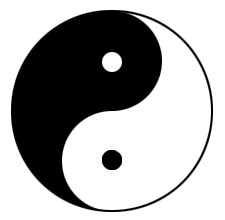25 Introduction

This symbol demonstrates the balance and interdependence of all things. The dark side of the image has a seed of light; the light side has a seed of darkness to illustrate that opposites are interdependent.
Confucianism and Daoism are religious and philosophic traditions that developed in the region that we know of as China today. Both traditions grew out of an ancient culture with specific ideas about cosmology, the nature of humanity, and how humans should act to be in harmony with the world.
The two religions that we refer to as Confucianism and Daoism are based on the teachings of men who interpreted the ancient traditions. Their prescriptions for human life are somewhat different, but their root assumptions about the universe and human nature are similar. This gives Chinese religions a basic sense of unity, even though its expression varies.
The Historical Overview below outlines the basic assumptions of the Chinese religious world view. This section explains the religious and cultural knowledge of ancient Chinese society. It also gives a brief overview of Kong Qiu (“Master Kong” 551-479 BCE), regarded as the founder of Confucianism; and the Laozi, a text that established Daoism.
